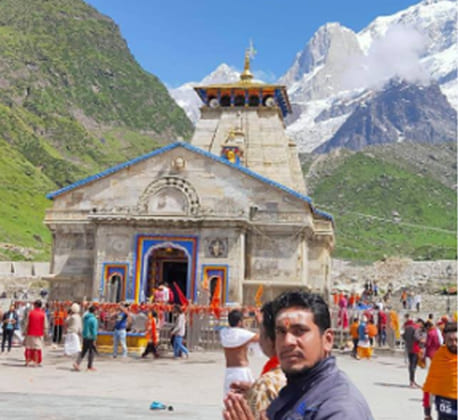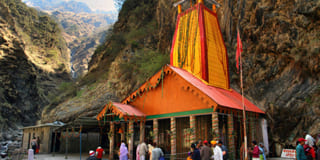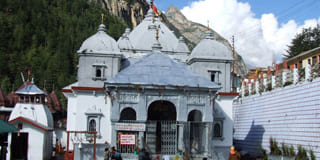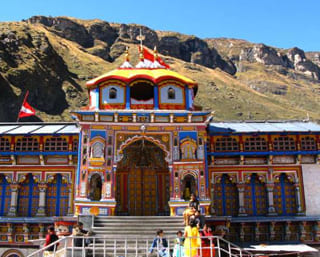The Char Dham of Uttarakhand is an important Hindu pilgrimage circuit in the Indian Himalayas. It is located in the Garhwal region of the state of Uttarakhand. This Hindu pilgrimage circuit consists of four sites: Yamunotri, Gangotri, Kedarnath and Badrinath.
The great Hindu philosopher and reformer Adi Shankaracharya initiated the Char Dham yatra in an attempt to revive the Hindu religion during the 8th century. The word 'Char Dham' refers to the four abodes of God, namely Badrinath, Kedarnath, Gangotri and Yamunotri at the Himalayan region of Garhwal (Uttrakhand). All these locations are believed to be highly sacred by the Hindu religion. While Kedarnath is home to lord Shiva and Badrinath is home to Lord Vishnu. Yamunotri represent goddess of Shakti Yamuna, and Gangotri represent goddess of Shakti Ganga..

The Holy Himalayas up in the misty heights of the majestic Garhwal Himalayas that adorn the magnificent state of Uttaranchal, awaits a rejuvenating spiritual experience for the devout.
Nestling in the lofty peaks are the four most holy pilgrimages of India - Yamunotri, Gangotri, Sri Kedarnathji and Sri Badrinathji, collectively referred to as the Char Dham (or four pilgrimage centres) of Hinduism. For centuries, saints and pilgrims in their search for the divine, have walked these mystical vales known in ancient Hindu scriptures as 'Kedarkhand'.
If the scriptures of HINDU RELIGION are to be believed, the holy centres of Gangotri, Yamunotri, Badrinath and Kedarnath - collectively called the Chardham (meaning four sacred spots) - are the mostsacred of all pilgrimages. Undertaking a journey to these places will not just wash away one's sins butensure release from the cycle of birth and death. The honour conferred on these places is not surprising.
For one, they are all in the icy Garhwal ranges and regarded as the most sacred of all Himalayan ranges. It is also said that heaven and earth converge in these holy spots and to be born or die here is a boon only the very fortunate have. The Chardham must be visited from left to right - beginning with Yamunotri, going on to Gangotri, Kedarnath and culminating the journey at Badrinath. This route follows the Hindu tradition of parikrama or clockwise circumambulation.
Yamunotri
The shrine of Yamunotri, situated at an elevation of about 3,235 m is a point of paramount religious importance for Hindus and an essential pilgrimage. Situated in the direction opposite to Gangotri, the road bifurcates from a place called Dharasu, somewhere between Rishikesh-Uttarkashi and goes on to Yamunotri. The shrine can also be visited via Mussoorie and Barkot.
Gangotri 
The shrine of Gangotri is situated at an elevation of 3048 m amidst captivating surroundings. Gangotri is located at a distance of 99 km from Uttarkashi. The temple, constructed by the Gorkha General Amar Singh Thapa, in the 18th century, is situated on the left bank of Bhagirathi. It is visited by lakhs of pilgrims every year. A number of ashrams are located on the other side, some of which provide accommodation facilities to the visitors.
Kedarnath
 Amidst the dramatic mountainscapes of the majestic Kedarnath range stands one of the twelve Jyotirlingas of Kedar or Lord Shiva. Lying at an altitude of 3584 m on the head of river Mandakini, the shrine of Kedarnath is amongst the holiest pilgrimages for the Hindus. There are more than 200 shrines dedicated to Lord Shiva in the district itself, the most important one is Kedarnath.
Amidst the dramatic mountainscapes of the majestic Kedarnath range stands one of the twelve Jyotirlingas of Kedar or Lord Shiva. Lying at an altitude of 3584 m on the head of river Mandakini, the shrine of Kedarnath is amongst the holiest pilgrimages for the Hindus. There are more than 200 shrines dedicated to Lord Shiva in the district itself, the most important one is Kedarnath.
According to legend, the Pandavas after having won over the Kauravas in the Kurukshetra war, felt guilty of having killed their own brothers and sought the blessings of Lord Shiva for redemption. He eluded them repeatedly and while fleeing took refuge at Kedarnath in the form of a bull. On being followed he dived into the ground, leaving his hump on the surface. The remaining portions of Lord Shiva appeared at four other places and are worshipped there as his manifestations. The arms appeared at Tungnath, the face at Rudranath, the belly at Madhmaheshwar and his locks (hair) with head at Kalpeshwar. Kedarnath and the four above mentioned shrines are treated as Panch Kedar.
An imposing sight, standing in the middle of a wide plateau surrounded by lofty snow covered peaks. The present temple, built in 8th century A.D. by Adi Shankaracharya, stands adjacent to the site of an earlier temple built by the Pandavas. The inner walls of the assembly hall are decorated with figures of various deities and scenes from mythology. Outside the temple door, a large statue of the Nandi Bull stands as guard. Dedicated to Lord Shiva, the exquisitely architectured Kedarnath temple is considered to be more than 1000 years old. Built of extremely large, heavy and evenly cut gray slabs of stones, it evokes wonder as to how these heavy slabs had been handled in the earlier days. The temple has a "Garbha Griha" for worship and a Mandap, apt for assemblies of pilgrims and visitors. A conical rock formation inside the temple is worshipped as Lord Shiva in his Sadashiva form.
Badrinath 
Guarded on either side by the two mountains Nar and Narayan, the Neelkanth Peak provides a splendid backdrop to Badrinath, one of the 'Char Dhams'. One of the most celebrated pilgrim spots in the country, it plays host to the famous Badrinath Temple. Legend has it that Lord Vishnu came to the area, called 'Badri Van', or the berry garden, to meditate after Narad rebuked the Lord for being immersed in worldly pleasures. The main deity is a meditating Lord Vishnu.
Facing the temple at the bank of Alaknanda River is a hot water spring known as "Tapt Kund", a bath in which is very refreshing to all travellers. Dedicated to Lord Vishnu, the temple of Shri Badrinathji, is 5 m high, built in the form of a cone with a small cupola of a gilt bull and spire. The temple opens every year in the month of April-May and closes for winters in the third week of November. Even though legend dates the temple back to the Vedic age, Guru Adi Shankaracharya has established the present temple. The temple has three parts - Garbha Grih (The Sanctum Sanctorum), Darshan Mandap (for pujas) and Sabha Mandap (for devotees to assemble).
Day 01: RISHIKESH TO JANKICHATTI
Welcome to Rishikesh on Breakfast after Breakfast drive to Jankichatti for journey to first of your Dham, Yamunotri, daughter of the Sun god Surya and consciousness Sangya. The Yamuna, like the Ganges, has been elevated to the status of a divine mother for the Hindus and has been held responsible for nurturing and developing the Indian civilization. Have lunch in-route at mid way Lakhamandal. Another journey breaks before Barkot to continue our final overnight destination Jankichatti, Dinner & Overnight at Jankichatti.
Jankichatti - Situated at an elevation of 2,650 mts above sea level, Jankichatti is primarily last motor able road head for pilgrims heading to Yamunotri. Jankichatti is surrounded by mountains on all sides and lies in close proximity of the Indo-China border. Previously the starting point of the trek to reach Yamunotri was Hanumanchatti. Since there is large devotee rush, it is advised to do night stay at Jankichatti to be among the first batch of pilgrims on this trekking route. Kharsali, the winter abode of Devi Yamuna and Sani Temple is on easy access from here. Besides Pilgrimage, there are numerous trekking options such as Darwa Top & Dodi Tal from Hanumanchatti, 7 kms from here. / Ponies and palanquins are available at Jankichatti.
Day 02: JANKICHATTI TO YAMUNOTRI TO JANKICHATTI
Early morning Wakeup call and leave with packed breakfast for trek to Yamunotri, your first of Himalayan Chardham. Return in time for Lunch at Jankichatti. Evening visit sightseeing tours of Jankichatti followed by Dinner. Overnight stay at Jankichatti.
Day's Engagement -
Yamunotri, First of The Chardham: The chief attraction at Yamunotri is the temple devoted to the Goddess Yamuna. The temple of Yamuna, on the left bank of the Yamuna, was constructed by Maharaja Pratap Shah of Tehri Garhwal. The deity is made of black marble. Yamunotri was the home of an ancient sage Asit Muni.
Yamuna is the daughter of the Sun just like Yama who is considered his son. It is believed that Yama would not torment any person at the time of death who bathes in Yamuna, his sister. It is Yamuna, who being a holder of infinite love and compassion can grant us freedom from even death, in the realm of her elder brother.
Day 03: JANKICHATTI TO UTTARKASHI
Post leisurely wakeup call and breakfast, leave for Uttarkashi, literally meaning Banaras/ Kashi of north. En route Journey breaks at Brahamkhal and Dharasu band. Later reach Uttarkashi in time for Lunch. Early Dinner & Overnight stay at Uttarkashi.
Uttarkashi - Uttarkashi is a small and beautiful town, situated between two rivers: Varuna and Ashi, whose water flow into the Bhagirathi from either side of the town. Elevated, at a height of 1588 meters, this little town is very similar to Kashi and Varanasi, in that it has the same kind of temples and ghats and likewise, a north or 'Uttar' facing river. The major temple in Uttarkashi is The Vishwanath Temple, dedicated to Lord Shiva. Two other very important temples are located in the Chowk area are the Annapurna Temple and the Bhairav Temple. Once it is said, there were 365 temples here. Hiuen Tsang referred to this place as Brahma Pura, while the Skanda Puran has recorded it as Varunavata. It is believed that in the second millennium of Kaliyug Kashi will be submerged, and Uttarkashi will replace it as an important religious centre.
Day 04: UTTARKASHI TO GANGOTRI TO UTTARKASHI
Early morning wakeup call and after light breakfast proceed for Gangotri. Enroute journey break at Ganganani, have bath in hot water spring, later continue for Gangotri temple. Post Puja, lunch at Gangotri. Later leave for Uttarkashi. Dinner & overnight say at Uttarkashi.
Day's Engagement -
Gangotri, IInd of Chardham: Gangotri, the origin of the River Ganges and seat of the goddess Ganga, is one of the four sites in the Char Dham pilgrimage circuit. The river is called Bhagirathi at the source and acquires the name Ganga (Ganges) from Devaprayag onwards where it meets the Alaknanda. The origin of the holy river is at Goumukh, set in the Gangotri Glacier, and is a 18 km trek from Gangotri.
This small town is centered around the temple of goddess Ganga, which was built by the Nepalese General, Amar Singh Thapa in the early 18th century. The temple is closed on Diwali day every year and is reopened in April/ May. According to Hindu mythology, Goddess Ganga took the form of a river to absolve the sins of King Bhagirathi's predecessors, following his severe penance of several centuries.
No other river is wound as closely with the warp and weft of Hinduism as the Ganga in India. Venerated since time immemorial as spiritual purifier and the giver of health and prosperity, it is part of the country's social and religious fabric. The irresistible attraction of these sacred waters, enhanced by the myths and legends woven around the river and its origins, has drawn ascetics and adventurers alike since mythical times. Gangotri, the temple dedicated to the Goddess Ganga near the source of the river and one of the Chardham of Uttarakhand is among the most sanctifying experiences of a Hindu's life; and as uplifting and inspiring for the traveler. Million of pilgrims and travelers have undertaken the yatra to Gangotri for centuries in search of salvation and the sacred river has provided those scours and hope.
Day 05: UTTARKASHI TO GUPTKASHI
After a very early breakfast leave for the longest journey of the trip on the road. Late Lunch en route. On the way see the heritage city of Tehri going down in to the mighty waters of Holy River Ganges, because of the construction of Tehri Dam. After lunch restart your journey and today for the first time see the river beautiful MANDAKINI. Travel along this to reach Guptkashi late in the evening. Diner and Overnight at hotel.
Day 06: GUPTKASHI TO PHATA TO KEDARNATH TO RUDRAPRYAG
Morning drive to Phata take helicopter flight to Kedarnath ji, do priority darshan here, and fly back to Phata and drive to Rudrapryag. Overnight stay at Rudrapryag.
Day's Engagement -
Kedarnath Temple, IIIrd of Chardham: Kedarnath, the remotest and the most magnificent of the Chardham, is located in Lord Shiva's own country. The sheer majesty of the shrine's natural setting - the towering mountains mantled in snow, the tumbling streams and rivers, and green meadows and forests -- and the arduous trek that gets you to it, serve to further cement the deep-rooted faith that this temple inspires in the devout. This is one sacred site that has remained almost unchanged for centuries and has a spiritual energy all its own. For the devotee of Lord Shiva, this is the last frontier, the ultimate path to salvation.
Kedarnath - Flight cost extra.
Day 07: RUDRAPRAYAG TO BADRINATH
After breakfast drive to Badrinath via Joshimath. Up arrive Check in Hotel. Later at evening visit Badrinath Temple for Aarti. Dinner & overnight stay will be hotel at Badrinath.
Day's Engagement-
Badrinath Temple, IVth of Chardham: Badrinath and its route is, for the newcomer, a journey of initiation. For those who are visiting the shrine, the landmarks and vistas forever provide a newer view, a different emotion, a further nuance to an experience in memory. The journey to Badrinath can sometimes be unforgiving, but only to a closed mind. The people visiting the shrine are but the faces of the country. Journey from Rishikesh to Badrinath, to borrow from one of Sir Edmund Hillary's expeditions, is in many ways, a journey from the ocean to the sky, as much mental as physical and another route to heaven - and spiritual liberation.
Day 08: BADRINATH TO JOSHIMATH
Early morning, pilgrims after having a bath in the Taptkund have the Darshan of Badrivishal. Brahamakamal is significant for Pinddan Shraddh of ancestors (Pitrus). There are other interesting sight seeing spot like Mana, Vyas Gufa, Maatamoorti, Charanpaduka, Bhimkund and the "Mukh" of the Saraswati River. Just within the three kms of Badrinathjee. Later drive back to Joshimath. Check in Hotel. Overnight will be hotel at Joshimath.
Day 09: JOSHIMATH TO RISHIKESH TO HARIDWAR
Early morning drive to Haridwar via Rishikesh on Arrive at Haridwar and transfer to Railway station Tour End hear.
© 2025 Feel Tourism | All Rights Reserved